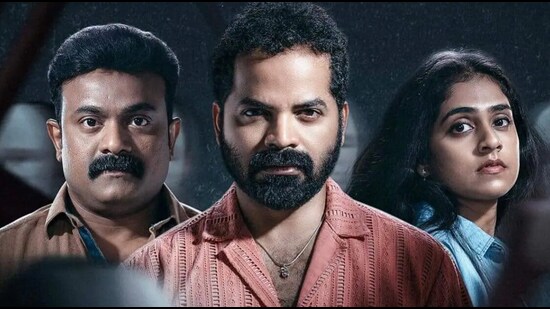In a scenario that gets repeat play in Sthal a.k.a. A Match, Savita Daulatrao Wandhare sits facing a gaggle of men in her home in rural Maharashtra. Clad in a sari, her gaze lowered as they scrutinise her, she responds meekly to their interrogation.

“What is your name?”
“What is your date of birth?”
“What is your height?”
It is a situation familiar to Indian women from families that take an unevolved route to arranged marriages. Once the men finish quizzing her, and polish off tea and snacks, they negotiate a dowry with her father as they leave. No one asks for her opinion on the proceedings.
Writer-director Jayant Digambar Somalkar’s Sthal (Marathi) is not the first film to spotlight India’s arranged marriage bazaar. It is, however, one of the starkest representations of the merciless microscope under which women are placed as they are paraded with soul-crushing regularity before potential husbands and their clans. Savita’s ambitions extend beyond marriage. Her parents nevertheless thrust her into this skewed market in which she is akin to a product for sale, but she must pay to be purchased.
The humiliation and cruel social pressure heaped on Savita (played by Nandini Chikte) are at the centre of Sthal, which has just been declared the first runner-up in the FIPRESCI-India Grand Prix for Best Indian Films of 2023. The winner of this selection by FIPRESCI-India — a chapter of the International Federation of Film Critics (FIPRESCI) — is the Malayalam film Aattam. The Garo-language Rapture a.k.a. Rimdogittanga is the second runner-up.
As a FIPRESCI-India member, I am thrilled at the array of beautiful films from which we got to choose. I’m also frustrated. Because although the three honourees have had an impressive festival run in 2023-24, only one is available for mainstream public viewing in India: Aattam, which was theatrically released this January, is now on Amazon Prime Video, but Sthal and Rapture have not reached theatres or streaming platforms so far. Therein lies a tale of independent Indian cinema’s struggles.
Director Anand Ekarshi’s Aattam, set in Kerala, is about a drama troupe’s response when its only woman actor (Zarin Shihab) is molested by one of their own. Dominic Megam Sangma’s Rapture revolves around a Meghalaya village where fear caused by a youth’s disappearance becomes a cover for xenophobia and violence. What these thematically disparate films have in common are ultra-naturalistic storytelling, artistic sensibilities undiluted by commerce, and producers who are not profit-fixated studios. Aattam’s casting is distinct from the other two though — the popular star Vinay Forrt plays one of its main characters, while Kalabhavan Shajohn, a well-known character artiste in commercial Malayalam cinema, has a significant supporting part. This does not mean the indie-spirited, unconventional Aattam had it easy, but it does underline the reality that a couple of high-profile figures in a cast could be advantageous in an exhibition ecosystem heavily weighted against such films.
Sthal and Rapture both premiered at reputed international festivals and have earned critical acclaim and prestigious awards in India and abroad. Rapture was even released in theatres across France this summer after it was picked up by a French distributor. You might think Indian exhibitors are waiting to grab these films, but that is not the case.
In the past approximately 15 years, theatres in India have gradually risen above their Hindi-centricity that earlier confined films of all other languages to states or regions in which they are primarily spoken. The initial improvement in the system was painfully slow, but Covid yielded dramatic changes when an unprecedented proportion of the audience was exposed to films across Indian languages on online platforms while confined to their homes during lockdowns. This made the long-running stagnation in mainstream Hindi cinema glaring, and when theatres re-opened, audiences demanded better. Unaccustomed as Hindi filmmakers are to competing on a somewhat level playing field with the rest of the country, they floundered further, thus compelling theatres to offer more space to other Indian cinemas.
As heartening as these developments may be, the parallel truth is that the chief beneficiaries of this language renaissance have been films by comparatively big producers with budgets to cast stars and promote their works. Exhibitors remain unadventurous. Result: Small-budget indies in all languages, including Hindi, remain marginalised. Anamika Haksar’s Ghode Ko Jalebi Khilane Le Ja Riya Hoon (Hindi, 2022) is among a tiny handful of indies that have made it to theatres since the pandemic.
Some independent filmmakers combat the gatekeeping at theatres by getting a star or two in their cast to make a project more sellable. Some try to find influential distributors or seek out prominent names as presenters to generate curiosity about their films. Some have taken a direct-to-streaming path. As it happens, streaming majors, though less resistant to independent cinema than theatres, do their own version of questionable gatekeeping, often avoiding films that are too experimental, contentious or niche in their dictionary.
The consequence is that for every Aattam coming to Indian theatres and online against all odds, scores of cinematic gems like Sthal and Rapture are yet to get there.
Anna MM Vetticad is an award-winning journalist and author of The Adventures of an Intrepid Film Critic. She specialises in the intersection of cinema with feminist and other socio-political concerns. The views expressed are personal


